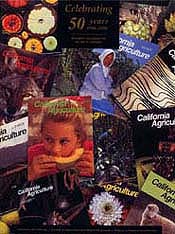All Issues

Celebrating 50 Years: 1946-1996
Cover:
A sampling of California Agriculture covers. Photo by Suzanne Paisley.

Recycled green waste: Can it find a home on the farm?
Cover:
In the response to the rapid depletion of landfill capacity, the California Legislature enacted a law mandating landfill disposal reductions of 25% by 1995 and 50% by the year 2000. Sonoma Composting diverts green waste from landfills and converts it into a rich soil amendment. Photo by Jack Kelly Clark.

Phylloxera spurs replanting of vineyards
Cover:
Jim Young, manager of Robert Young Vineyards in Sonoma County, inspects a block of recently planted SO-4 rootstock Phylloxera biotype B has devastated many North Coast wine grape vineyards, spurring growers to replant with resistant rootstocks such as SO-4. Photo by Jack Kelly Clark

Aerial imagery: Crop management goes high-tech
Cover:
This computer processed aerial photo of a uniformly managed sudangrass crop grown at the UC Davis Long term research on Agricultural Systems (LTRAS) site prior to starting a 100- year experiment, reveals subtle differences in soil fertility. Computer image courtesy of Ford Denison

Does firewood harvesting outpace tree growth?
Cover:
UC researchers monitor regeneration and stand structure in Tehama County to determine if tree growth has outpaced firewood harvest. Photo by Richard Standiford

Urban forests add $3.8 billion to economy
Cover:
The Rose Garden, a park in the city of Berkeley, is an example of urban forestry that provides residents with aesthetic, environmental and economic benefits. Photo by Jack Kelly Clark
November-December 1996
Volume 50, Number 6
Volume 50, Number 6





